A Corpus-based Study on the Existing Comments of the Literature Works:Hemingway’s A Clean,Well-Lighted Place
2021-02-19DUANRui-jun,HONGYang,MAWen-li
DUAN Rui-jun,HONG Yang,MA Wen-li
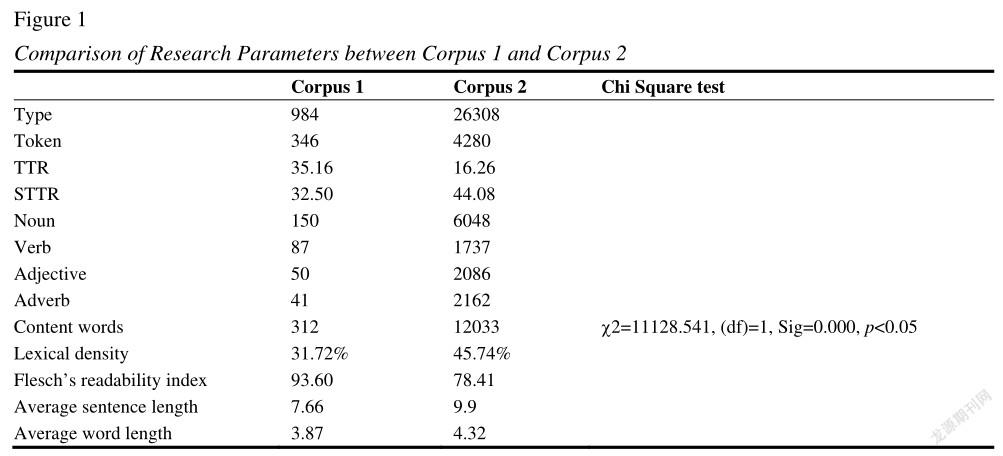

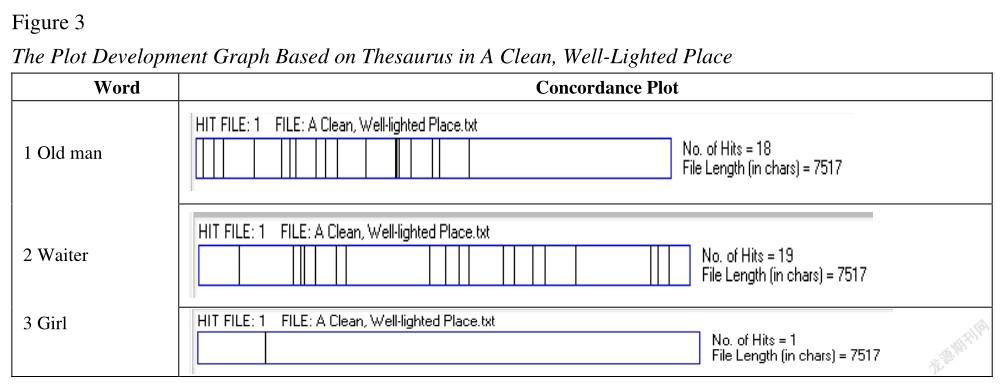
In recent years, the application of computer-aided technology of corpus linguistics to the quantitative analysis of literary texts has increasingly become a powerful supplement to the traditional text analysis of literary works. With the help of corpus linguistics, this paper aims to offer proof to the existing comments on Hemingways A Clean, Well-Lighted Place from an empirical perspective. And issues like its concise writing style, nihilistic theme, narrative plot and the character image analysis will be discussed.
Keywords: Hemingway, A Clean, Well-Lighted Place, corpus
Introduction
With the rapid development of computer and network technology since the 1980s, more and more scholars put the language and meaning of literary texts into the scope among the corpus linguistics (Toolan, 2009; Wynne, 2006; Kopley, 2016). Many scholars in China started to use corpora to analyze foreign literary works (Zhang & Xie, 2010; Zheng & Zheng, 2012). Corpus based literature research has gradually become a new research paradigm whose methodology is to use corpus analysis tools to describe literary texts quantitatively ranging from the aspects of pronunciation, vocabulary, syntax, semantics, pragmatics and etc., to topics like the theme, character image analysis, narrative development and writing styles. Due to the traditional literature research is mainly interpretive, which is based on personal reading experience, the results are more or less subjectively different (Lu & Xia, 2010). However, corpora could make the analysis results more objective and reliable, which has verified as a strong empirical support for individual interpretation of literary works (Zhao, 2011).
Previous studies on Hemingways work A Clean, Well-Lighted Place mainly focus on the literary dimensions which are related to the theme, writing style, characterization, symbolic analysis and narratological analysis (Wang, 2012; Zhang Zhang, 2015; Du, 2011). Other studies are from linguistics, such as the three meta-functions of systemic-functional grammar (Su, 2012). From cognitive linguistics Lin interpreted the psychological operation mechanism of spatial cognitive understanding in the process of online construction of discourse meaning in A Clean, well-lighted Place (Lin, 2013). Qiao tried to apply Austin and Searles speech act theory and indirect speech act theory for analyzing the characters speech acts in the text (Qian, 2013). There are also some studies from the perspective of translation (Liu & Fui, 2013).
By using the corpora tools, this research aims to offer proof to its following existing comments of the reading text A Clean, Well-Lighted Place:
(1) to obtain Hemingways “concise” writing style from the data of frequency list;
(2) to demonstrate the “Nihilism” theme of the work by looking at the abstract semantic domain from the thesaurus;
(3) to work out the story plot by analyzing the distribution and density of the character;
(4) to have a discourse analysis of the character image through the concordance line in terms of the linguistics features such as nouns, verbs, adjectives and adverbs.
Research Design
Corpus Building and Annotation
Corpus or corpora refers to a set of electronic texts collected according to certain collection standards, to some extent, which can represent a variety of a language (Liang, 2010). The corpora used in this research are: The Corpus of the literacy work of A Clean, Well-Lighted Place (Corpus 1, 20706 tokens, 3294 types) and a comparative Corpus of native English stories (Corpus 2, 20043 tokens, 4401 types) which collected 10 short English stories from Britain and the United States randomly. After the construction of the two corpora, we use computer aided corpus analysis tool named Treetagger to help us finish the work of (POS) part of speech, which can tag the words with noun, verb, adjective and etc. Meanwhile, manual tagging of marking the dialogues in this novel will be completed by ourselves. The rules are old customer as “ / - OC”, elderly waiter as “/- OW”, and young waiter as “/- YW”.
Corpus Analysis Tools and Research Issues
The data-driven corpus analysis is bottom-up, which means that it derives conclusions from specific data which can be verified repeatedly. Because of its objectivity and effectiveness, it has increasingly become a powerful data support for qualitative analysis of literary works. Based on different research parameters, quantitative data are obtained to prove the existing comments like concise writing style, nihilistic theme, narrative plot and the character image analysis with the help of corpus analysis tools of Antconc3.2.1, Wordsmith6.0, BFSU_Readability_ Analyzer_1.1.
Literature Review on the Literature Corpus
The Writing Style of Concise
This paper compares and analyses the lexical, syntactic and textual differences between Corpus 1 and Corpus 2 to demonstrate Hemingways “concise” writing style from multiple dimensions, such as the standardized type-token ratio (STTR), lexical density, average length of words and sentences, and Fritzs readability index.
Token refers to the total number of words in a text, while types refers to the total number of different word forms in a text. Type-token ratio (TTR) refers to the proportion of types and tokens in a corpus. The lower the ratio is, the smaller the variability degree of words is and the lower the difficulty of the text is, and vice versa.However, it is obviously irrational to use TTR to measure the degree of lexical variability. Therefore, the standardized type token ratio (STTR) is more rational. The larger the STTR value is, the greater the variability of words in the corpus is, and the richer the vocabulary is, and the lower the repetition rate of words is.
Lexical density refers to the proportion of notional words in the total number of words in a specific corpus. The formula for calculating words is: lexical density = notional words / total words × 100%. It is pointed out that the higher the lexical density is, the higher the frequency of notional words is, the greater the amount of text information is, and the higher the reading difficulty is (Hu, 2007). The content words have a stable lexical meaning, including nouns, real verbs, adjectives and adverbs. In comparison, other functional words, including pronouns, prepositions, conjunctions, articles, auxiliary verbs and other parts of speech, have no stable meaning and mainly play a grammatical role, According to Fleschs readability index, the higher the score is, the simpler the text is; on the contrary, the higher the difficulty coefficient is, the more difficult the text is. The lower the readability. The following is the calculation formula of Fleschs readability index: Flesch reading ease = 206.835- (1.015 × ASL) - (84.6 × ASW). ASL = average sentence length and ASW = average syllable number of words.
The Nihilism Analysis Based on Thesaurus
There exist significant differences in the choice and distribution of words in different texts, and the theme of the text can be reflected by its selections of its words. Therefore, by extracting the words or phrases with super high frequency in the text, we can determine the theme, thus summarizing its abstract semantic domain (Yang, 2002). The method of topic word extraction is to compare the target corpora with a larger reference corpora. In this paper, with the help of Antconc3.2.1, the extracted thesaurus is shown in Figure 2.
With the aid of Antconc3.2.1, we compare Corpus 1 with Corpus 2 to get the thesaurus, and the result can be abstractly summarized into three semantic domains: (1) the “Nihilism” semantic domain is constructed by the words Nada and nothing; (2) The semantic domain of “drinking”, which is constructed by words like café, waiter, brandy, drunk, glass, saucer and etc, which enables the readers to project a picture in a coffee shop or pub; (3)The semantic domain of “night”, which is constructed by words like night, light, go, bed, home, said and him, helping us to build a view in the evening.

The Plot Development Based on Concordance Plot
The concordance plot is based on the distribution and density of each subject word in the text generated by thesaurus which can directly reflect the development of the story (Zhang & Xie, 2010). By using the word graph function in Antconc3.21, we can produce the plot development map based on the theme words (as shown in Figure 3), with which readers can have an intuitive understanding of the plot development.

Firstly, we search the main characters and secondary characters in this novel: the old customer, the elderly waiter, the young waiter, the girl, and the soldier. By searching the word “old man”, we find that the old customer appears more frequently in the first half of the novel, which is consistent with the development of the story. Then, by searching for the word “waiter” (including the young and the elderly), we find that both of them appear in the whole novel, which support the views of predecessors. Secondly, as shown in the word graph, there is less distribution and lower density of the three important characters, the girl, the soldier and the bartender. In addition, by searching “Nada” and “nothing”, we find that “nothing” appears in the whole novel, which is in line with the previous scholars conclusion on the nihilism theme. Furthermore, Nadas density is high at the end of the text, which reflects the climax of the nihilism theme of the novel.
The Personality Analysis Based on Concordance Line
This part obtains the concordance lines under the micro context by searching the names of people, which demonstrates the characteristics the figures by analyzing its positive, negative and neutral semantic prosody among nouns, verbs, adjectives and adverbs.
With a word as the key word in the concordance, the other 7 or 8 words around it can be shown as a micro context, which can provide a reliable basis for the theme analysis and character analysis. Generally, those typical characters tend to have a relatively independent and complete characteristics.
In the whole article, the old man only speaks a few words: “another brand”, “a little more”, “thank you”. The old customer is 80 years old and his wife died. The deaf old man almost loses contact with the outside world, although he is rich, but his material wealth cant dispel his spiritual loneliness and despair. Being afraid to stay in the cold and empty home, he comes to the coffee shop every night to get drunk and seek temporary light and peace. Despite the lack of care from family members, the old man is not slovenly and still maintains dignity. Even if slightly drunk, he never forgets to express gratitude to the attendant. When the old man is asked rudely to leave by the anxious and selfish young waiter, the old customer still accept this reality with great restraint and magnanimity, although his attempt to get drunk cannot be fulfilled. To a certain extent, the old customer also belongs to the Hemingways writing style of “tough guy image”
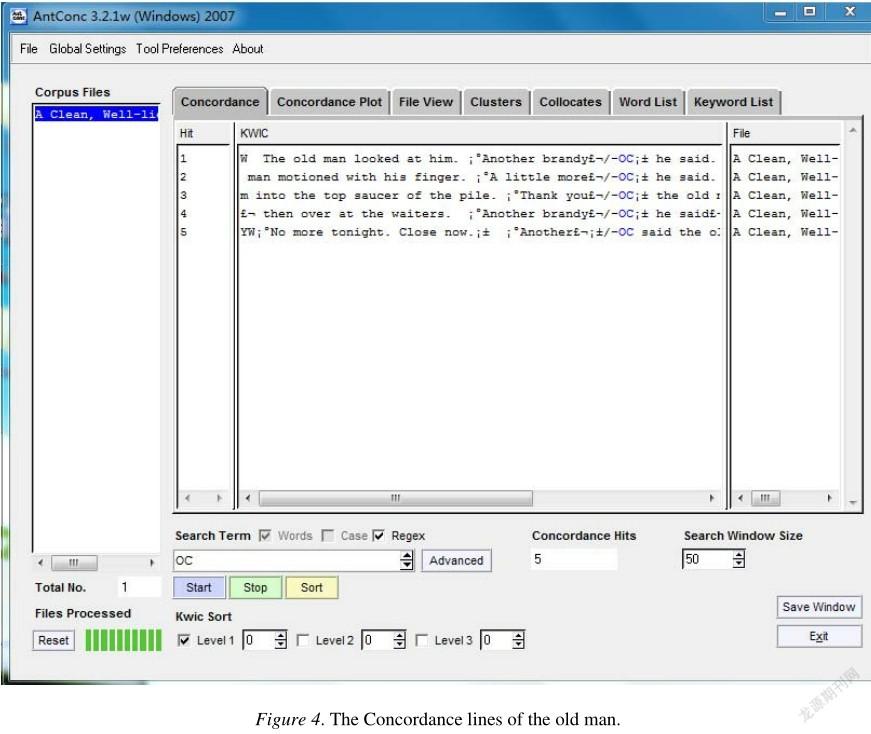
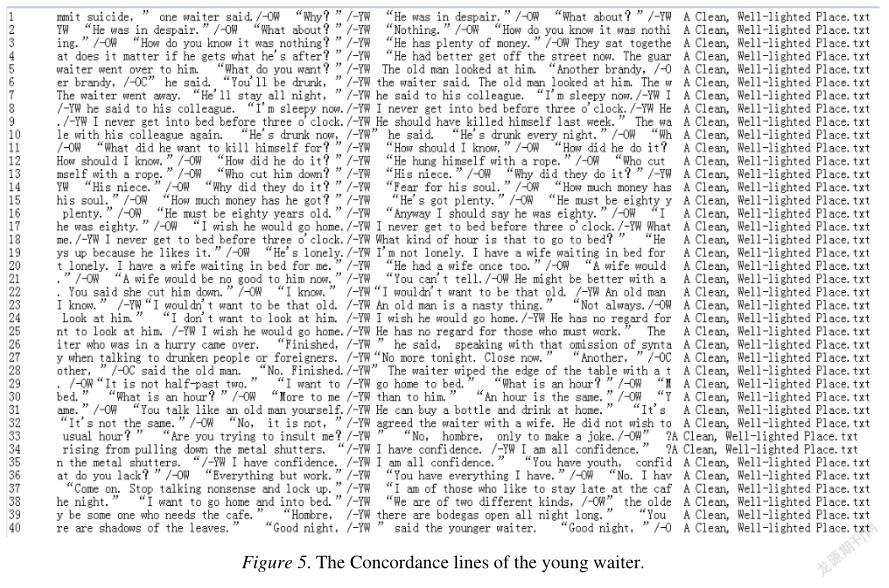
Two features about the young waiter can be seen from the concordance. First, there are 14 expressions of first person I in the young waiters words. The first person is a materialistic, selfish, indifferent and impetuous character. And then, the young waiters use a lot of words such as “doesnt matter”, “I dont”, “kill”, “no good”and “pretty thing”. Most of these words are derogatory, making their discourse atmosphere full of negative semantic rhymes.
Due to the shortage of life experience and the lack of independent thinking ability, the young waiter focuses superficially on the material level and do not have a profound understanding of himself. It seems that he has a stable job, a young age, company from his lover and good sleep. However, he doesnt know that all these things will be lost at any time. In fact, his heart is empty. When the elder waiter makes a joke with him about his wifes loyalty, he loses his temper immediately which implies that his self-confidence is based on these uncontrollable factors. His sensitivity just also shows that he realizes that his confidence and happiness are not strong enough subconsciously. He couldnt see that the spiritual despair of the old customer had nothing to do with the material. He thinks that the old people should commit suicide. He doesnt understand why the old people doesnt buy some wine and drink enough at home. He sneers that the old people doesnt have a wife. He has no interest in the inner spiritual world of the old custormer. He is selfish without professional ethics. He closes the door an hour ahead of time, drives the old man away rudely, and wants to go home earlier.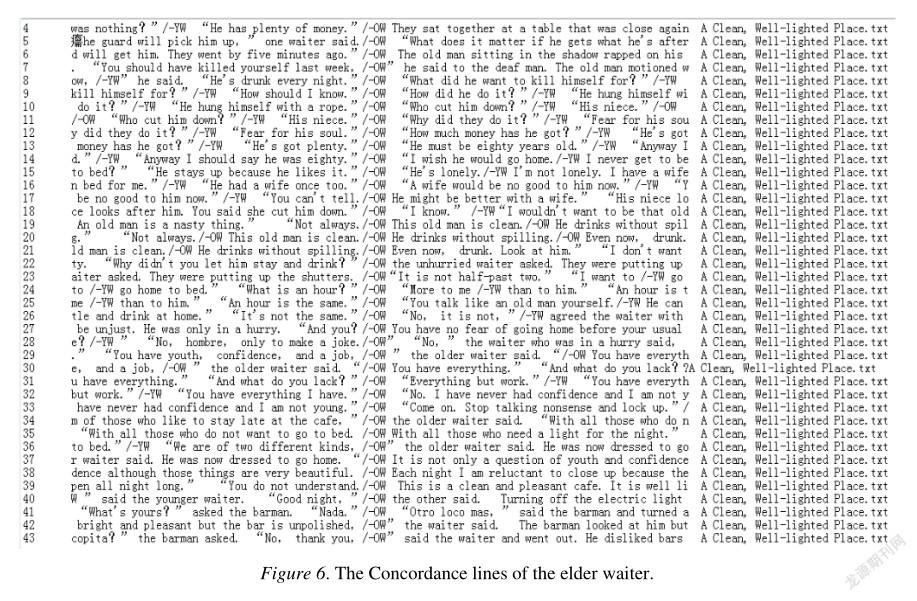
By contrast, the two features about the elder waiter can also be found from the concordance. The first person“I” appears 12 times, which is less used than the third person “he”, “she”, “it” and etc. The third person perspective is more objective because it does not mix the inner thoughts into language (Chen, 2007). This is consistent with the comments made by most literary scholars that the elder waiter is a mature and rational person with rich experience. And then, the elder waiter uses objective language expression, such as “had better do…”“should…” and “not always”. Finally, most of the words using by the elder waiter are neutral, making the language atmosphere full of neutral semantic rhyme.
The elder waiter clearly knows that he and the young waiter are two different kinds of people. He knows that he has no self-confidence, and is no longer young, and has nothing else but a job. He likes this job, not just to make a living. To him, this clean and bright cafe is a pure land that can let him escape from the nihilism for a short time. He understands the old customer and sympathizes with him. He thinks that if an old man could find a companion, his life would be better. He sincerely cares for the elderly and offers to help those people in the nihilism world with his own modest effort to provide them with a short, clean and bright space. He could not change the young waiters view, nor could he prevent the young waiter from swearing and dispelling the old customer. After closing the store, like the old customer, he tries to find a clean and bright place, looking for a short escape from the nihilism.
Conclusion
The research based on the data-driven corpus linguistics approach to explore the existing stylistic comments of the literacy work of Hemingways A Clean, Well-Lighted Place, verifying the previous research findings from an empirical perspective: issues like its concise writing style, nihilistic theme, narrative plot and the character image analysis are discussed with the help of corpus analysis tools.
References
Du, J. (2011). A narrative analysis of the English text of critical moments. Modern Chinese, 8(3), 21-23.
Hu, X. Y. (2007). A corpus-based study on the word features of Chinese translation novels. Foreign Language Teaching and Research, 5(3), 214-220.
Kopley, E. (2016). Virginia Woolfs conversations with George Rylands: Context of A Room of Ones Own and “craftsmanship”. Review of English studies, 67(282), 946-969.
Liang, M. Q., & Li, W. Z., & Xu, J. J. (2010). Using corpora: A practical coursebook. Foreign Languages Teaching and Research Press.
Lin, B. Z. (2012). The construction of Mental space network system of A Clean and Well-lighted Place. Journal of Changsha University of Science and Technology, 9(5), 113-118.
Liu, Y. Y., & Fu, Z. Y. (2013). Comments on the two translations of A Clean and Well-lighted Place. Journal of Guilin Normal College, 27(1), 85-88.
Lu, W. Z., & Xia, Y. (2010). Corpus stylistics: A new approach to literacy stylistics. Journal of Foreign Languages, 1(1), 47-53.
Qiao, H. (2013). The analysis of the speech act of the characters in the dialogue in A Clean and Well-lighted Place. Journal of Ningbo Institute of Education, 12(6), 53-57.
Su, L. Y. (2012). The analysis based on systemic-functional linguistics of A Clean and Well-lighted Place. Shi Ji Qiao, 9(3), 24-25.
Toolan, M. (2009). Narrative progression in the short story: a corpus stylistic approach. Amsterdam: John Benjamins Publishing Company.
Wang, L. (2012). On the writing style in Hemingways story A Clean and Well-lighted Place. Academic Exchange, 8(8), 184-186.
Wynne, M. (2006). Stylistics: corpus approach. In K. Brown (Ed.), Encyclopedia of language and linguistics (2nd ed.). Oxford: Elsevier Science.
Yang, H. Z. (2002). An introduction to the corpus linguistics. Shanghai: Shanghai Foreign Language Education Press.
Zhang, H. Y., & Xie, Q. F. (2010). A corpus-based study of appreciation of literary works: Take the Vietnamese novella “The Gone with the Wind” as an example. Journal of PLA University of Foreign Languages, 5(3), 57-61.
Zhang, Z. J. (2015). The character analysis of Hemingways story A Clean and Well-lighted Place. Foreign literatures, 5(2), 31-33.
Zhao, Y. G. (2010). Literacy pragmatics: New trend of literacy criticism—Tentative analysis of Agatha Christians Murder on the Orient Express. Journal of Baoji University of Arts and Sciences, 2(1), 96-101.
Zheng, W. T., & Zheng, F. (2012). The study of Magvichs self-redemption: A corpus-based text analysis. Journal of Beijing University of Aeronautics and Astronautics, 3(2), 97-100.
杂志排行
Journal of Literature and Art Studies的其它文章
- Overlapping or Reshaping:Chinese Image in Lin Yutang’s Trans-creation Works
- The Contribution of Blended Teaching Approach to the Promotion of Learner Autonomy
- Reflection:A Critical Look at Escaping Secondary Traumatic Stress Experienced by Law Enforcement Officers
- The Female Dilemma in The Grass Is Singing
- An Analysis of the Relation Between Phase,Situation and Aspect Suffix“LE”in Chinese
- Study on Chinese“Internet New Idioms”
